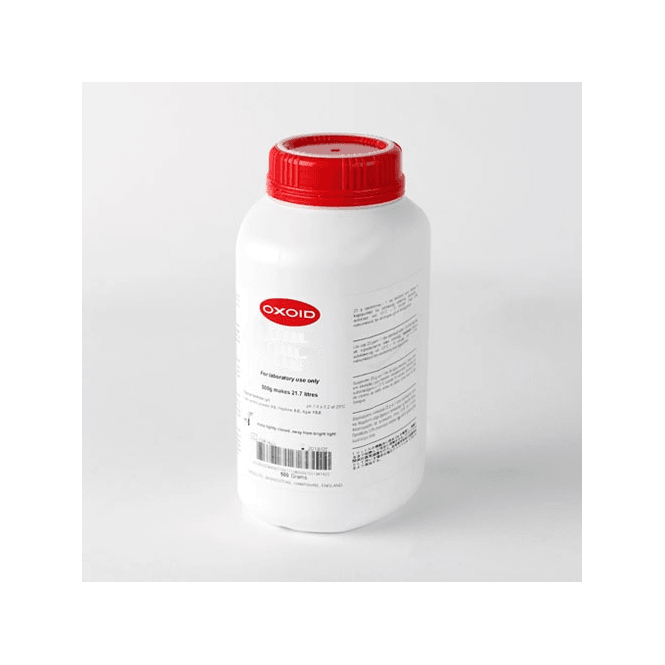Thermo Scientific™ Oxoid™ Lysine Iron Agar (Dehydrated)
Catalog No :
CAS Number :
Brand :
In Stock
A diagnostic medium for salmonellae including Salmonella arizonae
Specifications:
| Application | Microbiology | ||
| Storage Temperature | Room Temperature | ||
| Product Type | Culture Medium | Forms | Powder |
| Product Brand | Thermo Fisher Scientific™, Oxoid | ||
| Product Grade | Microbiology grade | ||
The Oxoid™ Lysine Iron Agar (LIA) is a differential diagnostic medium specifically formulated for detecting Salmonella spp., including Salmonella arizonae. This medium enables the identification of bacteria through lysine decarboxylase activity and hydrogen sulfide (H₂S) production, making it a vital tool for clinical, food safety, and research applications.
Key Features
- Differential Medium:
- Detects lysine decarboxylation, H₂S production, and other metabolic activities specific to Salmonella.
- Differentiates Salmonella spp. from other Enterobacteriaceae.
- Sensitive to Lactose-Fermenting Salmonellae:
- Allows detection of lactose-fermenting Salmonella arizonae, often missed by traditional media.
- Precise Identification:
- Differentiates between Salmonella, Proteus, Citrobacter, and other enteric bacteria based on metabolic reactions.
- Versatile Usage:
- Applicable in clinical microbiology for pathogen detection.
- Supports foodborne pathogen investigations.
- Ready-to-Prepare Formula:
- Dehydrated medium supplied for convenient preparation and storage.
Typical Formula (per litre)
| Ingredient | Concentration (g/L) |
|---|---|
| Bacteriological Peptone | 5.0 |
| Yeast Extract | 3.0 |
| Glucose | 1.0 |
| L-Lysine | 10.0 |
| Ferric Ammonium Citrate | 0.5 |
| Sodium Thiosulphate | 0.04 |
| Bromocresol Purple | 0.02 |
| Agar | 14.5 |
| pH | 6.7 ± 0.2 @ 25°C |
Preparation Instructions
- Suspend 34 g of dehydrated medium in 1 litre of distilled water.
- Heat to boiling to dissolve completely.
- Dispense into tubes.
- Sterilize by autoclaving at 121°C for 15 minutes.
- Cool tubes in an inclined position to form slants with deep butts.
Interpretation of Results
| Reaction Type | Slant | Butt | H₂S Production |
|---|---|---|---|
| Salmonella spp. | Alkaline | Alkaline | Positive |
| Proteus spp. | Red | Acid | Negative |
| Citrobacter spp. | Alkaline | Acid | Positive |
| Escherichia spp. | Alkaline | Acid/Neutral | Negative |
| Shigella spp. | Alkaline | Acid | Negative |
| Klebsiella spp. | Alkaline | Alkaline | Negative |
Note:
- Salmonella paratyphi A does not produce lysine decarboxylase, resulting in an alkaline slant and acid butt.
- Proteus species producing H₂S do not blacken this medium.
Storage Conditions
- Dehydrated Medium: Store at 10–30°C.
- Prepared Medium: Store at 2–8°C.
- Use before the expiry date indicated on the label.
Quality Control
| Control Organism | Expected Result |
|---|---|
| Enterobacter aerogenes ATCC 13048 | Slant: Alkaline; Butt: Alkaline; H₂S: Negative |
| Proteus mirabilis ATCC 29906 | Slant: Red; Butt: Acid; H₂S: Positive |
| Enterobacter cloacae ATCC 23355 | Slant: Alkaline; Butt: Acid; H₂S: Negative |
Applications
- Clinical Diagnostics:
- Identification of Salmonella infections, including lactose-fermenting Salmonella arizonae.
- Food Safety Testing:
- Detection of foodborne Salmonella spp. to ensure compliance with safety standards.
- Research:
- Studies on bacterial metabolism, particularly lysine decarboxylation and H₂S production.
Advantages
- Sensitive and Specific:
- Detects lactose and non-lactose fermenting Salmonella with high accuracy.
- Comprehensive Results:
- Differentiates multiple Enterobacteriaceae species in a single test.
- Ease of Preparation:
- Simple preparation and storage make it convenient for routine use.
The Oxoid™ Lysine Iron Agar (CM0381) is a reliable diagnostic medium designed for rapid detection and differentiation of Salmonella spp. and other Enterobacteriaceae based on metabolic characteristics. Its high sensitivity and specificity make it a valuable tool in clinical, food safety, and research laboratories.
References
- Edwards, P.R., and Fife, M.A. (1961). Appl. Microbiol. 9:478-480.
- Moeller, V. (1954). Acta Pathol. Microbiol. Scand. 355:259-277.
- Ewing, W.H., Davis, B.R., and Edwards, P.R. (1960). Pub. Hlth Labs. 18:77-83.
- Thatcher, F.S., and Clark, D.S. (1968). University of Toronto Press, p.100.
- Timms, L. (1971). Med. Lab. Technol. 28:150-156.
- Finegold, S.M., and Martin, W.J. (1982). Bailey & Scott’s Diagnostic Microbiology, 6th Ed., C.V. Mosby.




 0
0
